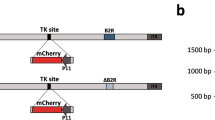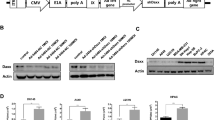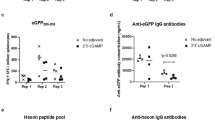Abstract
DNA-based alphaviral RNA replicon vectors, also called suicidal DNA vectors, alleviate the concerns of integration or transformation related to conventional DNA vectors since suicidal DNA vectors eventually cause apoptosis of transfected cells. However, the expression of inserted genes in these vectors is transient and the potency of suicidal DNA vaccines may be compromised because of apoptotic cell death. Therefore, to enhance the immune response to the human papillomavirus type 16 (HPV-16) E7 antigen, we generated a DNA-based Semliki Forest virus vector, pSCA1, encoding E7 fused with BCL-xL, an antiapoptotic member of the BCL-2 family. Our results indicated that pSCA1 encoding E7/BCL-xL fusion protein delayed cell death in the pSCA1-transfected dendritic cell line and generated significantly higher E7-specific CD8+ T-cell-mediated immune responses and better antitumor effects than pSCA1 encoding wild-type E7 gene in vaccinated mice. The antiapoptotic function of BCL-xL is important for the enhancement of antigen-specific CD8+ T-cell responses in vaccinated mice, because a point mutant of BCL-xL lacking antiapoptotic function was ineffective. These results suggest that strategies to delay suicidal DNA-induced cell death using antiapoptotic proteins may greatly enhance the potency of suicidal DNA.
This is a preview of subscription content, access via your institution
Access options
Subscribe to this journal
Receive 12 print issues and online access
$259.00 per year
only $21.58 per issue
Buy this article
- Purchase on Springer Link
- Instant access to full article PDF
Prices may be subject to local taxes which are calculated during checkout



Similar content being viewed by others
References
Donnelly JJ, Ulmer JB, Shiver JW, Liu MA . DNA vaccines. Annu Rev Immunol 1997; 15: 617–648.
Gurunathan S, Klinman DM, Seder RA . DNA vaccines: immunology, application, and optimization. Annu Rev Immunol 2000; 18: 927–974.
Condon C et al. DNA-based immunization by in vivo transfection of dendritic cells. Nat Med 1996; 2: 1122–1128.
Porgador A et al. Predominant role for directly transfected dendritic cells in antigen presentation to CD8+ T cells after gene gun immunization. J Exp Med 1998; 188: 1075–1082.
Berglund P et al. Enhancing immune responses using suicidal DNA vaccines. Nat Biotechnol 1998; 16: 562–565.
Leitner WW et al. Enhancement of tumor-specific immune response with plasmid DNA replicon vectors. Cancer Res 2000; 60: 51–55.
Hsu KF et al. Enhancement of suicidal DNA vaccine potency by linking Mycobacterium tuberculosis heat shock protein 70 to an antigen. Gene Therapy 2001; 8: 376–383.
Chen CH et al. Enhancement of DNA vaccine potency by linkage of antigen gene to an HSP70 gene. Cancer Res 2000; 60: 1035–1042.
Cheng EH et al. Bax-independent inhibition of apoptosis by Bcl-XL. Nature 1996; 379: 554–556.
Shen Z, Reznikoff G, Dranoff G, Rock KL . Cloned dendritic cells can present exogenous antigens on both MHC class I and class II molecules. J Immunol 1997; 158: 2723–2730.
Lin KY et al. Treatment of established tumors with a novel vaccine that enhances major histocompatibility class II presentation of tumor antigen. Cancer Res 1996; 56: 21–26.
Ji H et al. Targeting human papillomavirus type 16 E7 to the endosomal/lysosomal compartment enhances the antitumor immunity of DNA vaccines against murine human papillomavirus type 16 E7-expressing tumors. Hum Gene Ther 1999; 10: 2727–2740.
Pirtskhalaishvili G et al. Transduction of dendritic cells with Bcl-xL increases their resistance to prostate cancer-induced apoptosis and antitumor effect in mice. J Immunol 2000; 165: 1956–1964.
Boise LH et al. bcl-x, a bcl-2-related gene that functions as a dominant regulator of apoptotic cell death. Cell 1993; 74: 597–608.
Vaux DL, Cory S, Adams JM . Bcl-2 gene promotes haemopoietic cell survival and cooperates with c-myc to immortalize pre-B cells. Nature 1988; 335: 440–442.
Hockenbery D et al. Bcl-2 is an inner mitochondrial membrane protein that blocks programmed cell death. Nature 1990; 348: 334–336.
Deveraux QL, Takahashi R, Salvesen GS, Reed JC . X-linked IAP is a direct inhibitor of cell-death proteases. Nature 1997; 388: 300–304.
Pan G, O’Rourke K, Dixit VM . Caspase-9, Bcl-XL, and Apaf-1 form a ternary complex. J Biol Chem 1998; 273: 5841–5845.
Muzio M et al. FLICE, a novel FADD-homologous ICE/CED-3-like protease, is recruited to the CD95 (Fas/APO-1) death-inducing signaling complex. Cell 1996; 85: 817–827.
Kim TW et al. Enhancing DNA vaccine potency by coadministration of DNA encoding antiapoptotic proteins. J Clin Invest 2003; 112: 109–117.
Kharbanda S et al. Role for Bcl-xL as an inhibitor of cytosolic cytochrome c accumulation in DNA damage-induced apoptosis. Proc Natl Acad Sci USA 1997; 94: 6939–6942.
Du C et al. Smac, a mitochondrial protein that promotes cytochrome c-dependent caspase activation by eliminating IAP inhibition. Cell 2000; 102: 33–42.
Verhagen AM et al. Identification of DIABLO, a mammalian protein that promotes apoptosis by binding to and antagonizing IAP proteins. Cell 2000; 102: 43–53.
Sun XM et al. Bcl-2 and Bcl-xL inhibit CD95-mediated apoptosis by preventing mitochondrial release of Smac/DIABLO and subsequent inactivation of XIAP. J Biol Chem 2002; 277: 11345–11351.
Medema JP, Scaffidi C, Krammer PH, Peter ME . Bcl-xL acts downstream of caspase-8 activation by the CD95 death-inducing signaling complex. J Biol Chem 1998; 273: 3388–3393.
Wong BR et al. TRANCE (tumor necrosis factor [TNF]-related activation-induced cytokine), a new TNF family member predominantly expressed in T cells, is a dendritic cell-specific survival factor. J Exp Med 1997; 186: 2075–2080.
Esche C et al. CD154 inhibits tumor-induced apoptosis in dendritic cells and tumor growth. Eur J Immunol 1999; 29: 2148–2155.
Ploemacher RE, van Soest PL, Voorwinden H, Boudewijn A . Interleukin-12 synergizes with interleukin-3 and steel factor to enhance recovery of murine hemopoietic stem cells in liquid culture. Leukemia 1993; 7: 1381–1388.
Bykovskaia SN et al. The generation of human dendritic and NK cells from hemopoietic progenitors induced by interleukin-15. J Leukoc Biol 1999; 66: 659–666.
Medema JP et al. Expression of the serpin serine protease inhibitor 6 protects dendritic cells from cytotoxic T lymphocyte-induced apoptosis: differential modulation by T helper type 1 and type 2 cells. J Exp Med 2001; 194: 657–667.
Mendoza RB, Cantwell MJ, Kipps TJ . Immunostimulatory effects of a plasmid expressing CD40 ligand (CD154) on gene immunization. J Immunol 1997; 159: 5777–5781.
Kim JJ et al. In vivo engineering of a cellular immune response by coadministration of IL-12 expression vector with a DNA immunogen. J Immunol 1997; 158: 816–826.
Xin KQ et al. IL-15 expression plasmid enhances cell-mediated immunity induced by an HIV-1 DNA vaccine. Vaccine 1999; 17: 858–866.
Huang AY, Bruce AT, Pardoll DM, Levitsky HI . In vivo cross-priming of MHC class I-restricted antigens requires the TAP transporter. Immunity 1996; 4: 349–355.
Ji H et al. Targeting human papillomavirus type 16 E7 to the endosomal/lysosomal compartment enhances the antitumor immunity of DNA vaccines against murine human papillomavirus type 16 E7-expressing tumors. Hum Gene Ther 1999; 10: 2727–2740.
Acknowledgements
We thank Drs Robert J Kurman, Keerti V Shah, and Drew M. Pardoll for helpful discussions. We would also like to thank Drs Ralph Hruban, Ken-Yu Lin, and Richard Roden for a critical review of the manuscript. This work was supported by the National Cancer Institute, the Cancer Research Institutes, and the American Cancer Society.
Author information
Authors and Affiliations
Rights and permissions
About this article
Cite this article
Kim, T., Hung, CF., Juang, J. et al. Enhancement of suicidal DNA vaccine potency by delaying suicidal DNA-induced cell death. Gene Ther 11, 336–342 (2004). https://doi.org/10.1038/sj.gt.3302164
Received:
Accepted:
Published:
Issue Date:
DOI: https://doi.org/10.1038/sj.gt.3302164
Keywords
This article is cited by
-
The Need for Therapeutic HPV Vaccines as a Means of Curbing the Menace of Cervical Cancer
Indian Journal of Gynecologic Oncology (2021)
-
Perspectives for therapeutic HPV vaccine development
Journal of Biomedical Science (2016)
-
Priming with two DNA vaccines expressing hepatitis C virus NS3 protein targeting dendritic cells elicits superior heterologous protective potential in mice
Archives of Virology (2015)
-
Immunologic treatments for precancerous lesions and uterine cervical cancer
Journal of Experimental & Clinical Cancer Research (2014)
-
Adenovirus-mediated gene transfer of interleukin-23 shows prophylactic but not therapeutic antitumor effects
Cancer Gene Therapy (2008)



